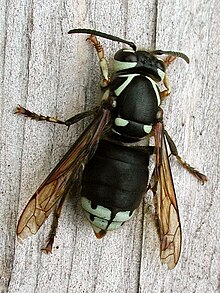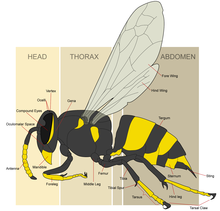Dolichovespula
| Dolichovespula | |
|---|---|

| |
| Dolichovespula maculata | |
| Scientific classification | |
| Domain: | Eukaryota |
| Kingdom: | Animalia |
| Phylum: | Arthropoda |
| Class: | Insecta |
| Order: | Hymenoptera |
| Family: | Vespidae |
| Subfamily: | Vespinae |
| Genus: | Dolichovespula Rohwer, 1916 |
| Type species | |
| Vespa maculata Linnaeus, 1763[1]
| |
| Subgenera | |
| |
Dolichovespula is a small genus of social wasps distributed widely throughout the Northern Hemisphere. The yellow and black members of the genus are known by the common name yellowjackets in North America, such as Dolichovespula norwegica, along with members of their sister genus Vespula. In a study on the nesting biology of Dolichovespula, a colony of D. maculata with 771 workers was reported as having the largest recorded population count.[2]
Overview


A set of morphological differences distinguishes them from Vespula. The most noticeable is the long face (dolikhos = "long" in Greek). Viewed from the front, Dolichovespula faces are long, while Vespula faces are short and round. The oculomalar space, the distance between the eye and the mandible, is long in Dolichovespula and short in Vespula.
Dolichovespula nests are usually aerial, while Vespula spp. often nest underground.
Reproduction
All females are born with reproductive capacities. Dolichovespula is unique from its sister group Vespula in that some of the workers create haploid offspring that develop into males.[3]
Species
These species are recognised:[4][5][6]
- Dolichovespula adulterina (Buysson, 1905)
- Dolichovespula albida Sladen 1918 – (split from D. norwegica)
- Dolichovespula alpicola Eck 1984 – Rocky Mountain aerial yellowjacket
- Dolichovespula arenaria (Fabricius, 1775) – aerial yellowjacket
- Dolichovespula arctica Rohwer 1918 – parasitic yellowjacket (split from D.adulterina)
- Dolichovespula asiatica Archer, 1981
- Dolichovespula baileyi Archer, 1987
- Dolichovespula carolina (Linnaeus, 1767)
- Dolichovespula flora Archer, 1987[7]
- Dolichovespula kuami Kim, 1996
- Dolichovespula lama (Buysson, 1903)
- Dolichovespula loekenae Eck, 1980 (split from D. pacifica)
- Dolichovespula maculata (Linnaeus, 1763) – bald-faced hornet
- Dolichovespula media (Retz., 1783) – median wasp
- Dolichovespula norvegicoides (Sladen, 1918) – Arctic yellowjacket
- Dolichovespula norwegica (Fabricius 1781) – Norwegian wasp
- Dolichovespula omissa (Bischoff, 1931)
- Dolichovespula pacifica (Birula, 1930)[8]
- Dolichovespula pacifica xanthicincta Archer, 1980[8]
- Dolichovespula panda Archer, 1980[8]
- Dolichovespula saxonica (Fabricius, 1793) – Saxon wasp
- Dolichovespula sinensis (Archer, 1987)[7][9]
- Dolichovespula stigma Lee 1986
- Dolichovespula sylvestris (Scopoli, 1763) – tree wasp
References
- ^ James M. Carpenter & Jun-ichi Kojima (1997). "Checklist of the species in the subfamily Vespinae (Insecta: Hymenoptera: Vespidae)" (PDF). Natural History Bulletin of Ibaraki University. 1: 51–92.
- ^ Archer, Michael E. (September 2006). Taxonomy, distribution and nesting biology of species of the genus Dolichovespula. Entomological Science 9(3):281–293.
- ^ Foster, Kevin R.; Ratnieks, Francis L. W.; Gyllenstrand, Niclas; Thorén, Peter A. (2001). "Colony kin structure and male production in Dolichovespula wasps" (PDF). Molecular Ecology. 10 (4). Wiley Publishing: 1003–1010. doi:10.1046/j.1365-294x.2001.01228.x. ISSN 0962-1083. S2CID 12009153.
- ^ Lynn S. Kimsey; James M. Carpenter (2012). "The Vespinae of North America (Vespidae, Hymenoptera)". Journal of Hymenoptera Research. 28: 37–65. doi:10.3897/jhr.28.3514.
- ^ "Dolichovespula". Animal Diversity Web. Regents of the University of Michigan. Retrieved 11 January 2017.
- ^ "Dolichovespula Rohwer, 1916 Ampiaiset?". funet.fi. Retrieved 12 January 2017.
- ^ a b "Archer (1987a) Three new species of Dolichovespula from China (Hymenoptera Vespidae) - Design - The Best Way to Share & Discover Documents". DocGo.Net. Retrieved 2018-08-23.
- ^ a b c Daglio, Anthony. "Archer (1980) A new species of Dolichovespula (Hymenoptera Vespidae) and subspecies of D.pacifica from China". Retrieved 2018-08-23.
{{cite journal}}: Cite journal requires|journal=(help) - ^ https://research.amnh.org/iz/f/Carpenter_Kojima_1997_ves.pdf
- "Dolichovespula". www.nic.funet.fi. Retrieved 2008-11-17.
- Bald-faced hornet. Baldfacedhornet.net
External links
 Media related to Dolichovespula at Wikimedia Commons
Media related to Dolichovespula at Wikimedia Commons Data related to Dolichovespula at Wikispecies
Data related to Dolichovespula at Wikispecies
